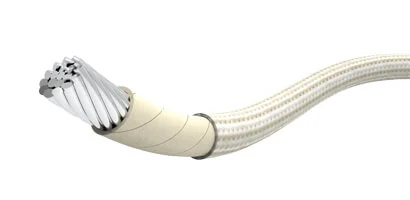550°C & Above Ultra-High Temperature Wire & Cables are designed for extreme heat situations that exceed 550°C. They are made of sophisticated materials and have great thermal stability and dependability, making them necessary for crucial industrial activities that require uncompromised performance in harsh environments.

Operating Temperature: +1000°C
Operating Voltage: 300 / 600V
Insulation: composites
Approval: IEC 60332

Operating Temperature: -60°C to +550°C
Operating Voltage: 300 / 600V
Insulation: composites
Approval: IEC 60332

Operating Temperature: -60°C to +550°C
Operating Voltage: 300V
Insulation: composites
Approval: UL/cUL (in progress)

Operating Temperature: -60°C to +550°C
Operating Voltage: 600V
Insulation: composites
Approval: UL/cUL (in progress)

Operating Temperature: +750°C
Operating Voltage: 300 / 600V
Insulation: composites
Approval: IEC 60332
1. Selection of High-Temperature Materials:
Insulation Materials:
Utilize advanced insulation materials with exceptional thermal stability and mechanical properties at temperatures exceeding 550°C.
Common materials include ceramic fibers (e.g., alumina, silica), refractory metals (e.g., tungsten, molybdenum), and specialty coatings or composites.
Conductor Materials:
Choose high-temperature conductive materials such as nickel-based superalloys (e.g., Inconel), refractory metals (e.g., tungsten, molybdenum), or advanced metal alloys with high melting points and excellent heat resistance.
2. Design Considerations for Mechanical Durability:
Reinforcement and Stranding:
Implement robust reinforcement techniques such as braiding, twisting, or stranding to enhance mechanical strength and resistance to mechanical stress.
Use high-strength materials for wire cores and conductors to withstand thermal expansion and contraction.
Jacketing and Protective Sheathing:
Apply durable outer jackets or protective sheathing made from heat-resistant materials to shield wires from abrasion, impact, and environmental factors.
Choose materials that offer flexibility without compromising thermal performance.
3. Flexibility and Bend Radius:
Optimized Cable Configuration:
Design cables with optimal flexibility and bend radius to facilitate installation and routing in confined spaces.
Balance mechanical flexibility with thermal stability to prevent kinking or damage during installation or operation.
Strain Relief Features:
Incorporate strain relief elements such as flexible connectors, grommets, or molded transitions to minimize stress concentration at cable terminations.
Ensure connectors and terminations are mechanically secure and compatible with high-temperature environments.
4. Testing and Validation:
Mechanical Testing:
Conduct mechanical tests including tensile strength, elongation at break, and flexural testing to evaluate wire and cable durability under extreme conditions.
Simulate real-world operating conditions to assess performance in high-temperature environments.
Environmental Testing:
Subject wires and cables to thermal cycling, vibration, and mechanical shock tests to validate durability and reliability.
Evaluate performance under simulated operational stresses to identify potential failure modes and design improvements.
5. Customization and Application-Specific Solutions:
Collaborative Design Approach:
Work closely with customers and industry partners to develop customized wire and cable solutions tailored to specific application requirements and environmental conditions.
Consider factors such as installation constraints, equipment compatibility, and service life expectations.
1. High-Temperature Insulation:
Exceptional Thermal Stability:
Utilize advanced insulation materials capable of withstanding continuous temperatures of 550°C and above without degradation.
Insulation materials may include ceramic fibers (e.g., alumina, silica), refractory metals (e.g., tungsten, molybdenum), and specialty coatings or composites.
Low Thermal Conductivity:
Maintain low thermal conductivity to minimize heat transfer along the wire or cable length, preserving the integrity of the insulation and protecting adjacent components.
2. Heat-Resistant Conductor Materials:
High Melting Point Alloys:
Incorporate conductive materials with high melting points and excellent heat resistance, such as nickel-based superalloys (e.g., Inconel), refractory metals (e.g., tungsten, molybdenum), or advanced metal alloys.
Ensure consistent electrical conductivity and mechanical strength at elevated temperatures.
3. Mechanical Durability and Flexibility:
Robust Construction:
Employ reinforcement techniques such as braiding, stranding, or wrapping to enhance mechanical strength and resistance to mechanical stress.
Design cables with durable outer jackets or protective sheathing to shield against abrasion, impact, and environmental factors.
Optimized Flexibility:
Balance mechanical flexibility with thermal stability to accommodate bending and routing during installation without compromising performance.
Incorporate strain relief features and flexible connectors to minimize stress concentration at cable terminations.
4. Chemical and Environmental Resistance:
Corrosion Resistance:
Choose materials resistant to chemical exposure, including acids, alkalis, and corrosive gases encountered in industrial and high-temperature environments.
Apply protective coatings or surface treatments to enhance corrosion resistance and prolong service life.
5. Electrical Performance:
Consistent Electrical Properties:
Maintain stable electrical conductivity, insulation resistance, and dielectric strength under extreme heat conditions.
Minimize electrical losses and optimize signal integrity for critical applications in aerospace, automotive, and industrial sectors.
6. Reliability and Safety:
Adherence to Standards:
Comply with industry standards and specifications (e.g., MIL-STD, ASTM) for performance, durability, and safety in high-temperature applications.
Undergo rigorous testing and validation to ensure reliability and long-term durability in demanding environments.
7. Application-Specific Customization:
Tailored Solutions:
Collaborate with customers and industry partners to develop customized wire and cable solutions tailored to specific application requirements and environmental conditions.
Consider factors such as installation constraints, equipment compatibility, and regulatory compliance.